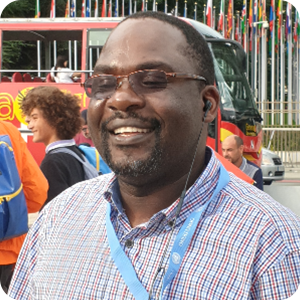Each January, the world celebrates the International Day of Education to praise and promote equitable access to knowledge and learning as a powerful driver to eradicating poverty. In recent years, the education sector has been severely affected by multiple crises, of which COVID-19 was possibly the worst. Coronavirus cases aside, schools faced severe staff shortages and high rates of absenteeism and quarantine. With additional triggers such as poverty, conflicts and marginalization, the number of out-of-school youth has jumped to 244 million. That is why the theme of this year’s Education Day on January 24 is “To invest in people, prioritize education”.
For this special day, we discussed current topics related to the education sector with international development aid experts in the field. Check out their opinions below.
Key Takeaways:
- Latest data shows that of the world’s 787 million children of primary school age, as many as 63 million, or 8%, do not attend school.
- COVID-19 has changed the traditional education system, with clear signs that it is becoming obsolete and vulnerable.
- As traditional methods fail to keep pace, this limited/no agility will most likely be solved by embracing artificial intelligence (AI) at the expense of human resources, according to experts questioned by DevelopmentAid.
- Russia’s invasion of Ukraine has severely disrupted the already constrained food, energy, and financial markets with various impacts on education worldwide.
DevelopmentAid: What was the greatest challenge the education sector faced in 2022?

“The outbreak of the COVID-19 pandemic in the first quarter of 2020 exacerbated the challenges facing education. Among these challenges is ensuring its continuity in the context of health, security and humanitarian crises. challenges, Thus, the use of digital technology to facilitate access to quality education and training is now emerging as the greatest challenge facing players in the educational world.”

“Limited/no access to clean energy together with climate change effects were the greatest challenges. As education is dependent on other sectors of the economy that are also enabled by access to energy, its limiting has resulted in a cascaded series of challenges. Weather disasters driven by climate change have affected vulnerable economic sectors thereby compromising the quality of education and also the lives of flora and fauna (including humans). Unsustainable human interaction with the environment is the main cause of global warming attributed to climate change. Due to anthropogenic activities that release greenhouse gas emissions, the global climate has been ever-changing and entering into a state of emergency. Emergency conditions call for a focus on life-threatening needs at the expense of other needs such as education.”

“The greatest challenge facing the education sector in 2022 varied from region to region. In poor African countries, particularly in Sahel countries, the COVID-19 pandemic combined with insecurity, conflicts, and terrorist attacks on populations and schools, have led to massive population displacements and the closure of thousands of schools. In this region, the greatest challenge is to be able to develop appropriate and inclusive emergency education alternatives to meet the needs of thousands of children in insecure areas or in host areas of the displaced.”

“The greatest challenge facing the education sector is the shortage of government investment in implementing policies and deploying multi-sectoral approaches that support inclusive, transformative and resilient education in an accountable and result-oriented manner. For instance, in 2022, stagnation was experienced in Nigerian public universities as they were closed due to a strike by lecturers from February to October. Also, the systemic issues around limited teaching and learning resources and poor infrastructure and technology for education continue to hinder the functionality of schools in the face of shocks. Floods also had negative impacts on education: a UN report states that flooding occurred in about 31 of Nigeria’s 36 states, taking a toll on education as schools and learning facilities have been submerged in many communities and this has caused pupils to lose learning time as their schools were inaccessible and damaged. The lack of preparedness of the education sector to adapt in the face of shocks is becoming a major barrier to the delivery of its mandate to learners.”
See also: An overview of equity in education. Why is it important?

“Equitability of access to education services continues to be low for female learners in most developing countries with the common barriers to girls’ education globally being:
i. Gender norms, roles, and social attitudes towards education: negative parental and community attitudes, perceptions and behaviours towards girls’ education which is deemed as unnecessary hence justifying excessive time-consuming domestic obligations, restrictive feminine fields of study, restricted mobility, early and forced child marriages, etc.
ii. Poverty: high cost to enroll girls in school; increased pressure for girls to financially support the family; direct and indirect opportunity costs of educating girls.
iii. Safety and security (physical and psycho-social): females are generally more prone to sexual and gender-based violence in and out of school but this is worse in conflict/fragile/emergency contexts.
iv. Teachers and teaching: gender-insensitive teaching by teachers with negative attitudes towards girls and gender-inequitable pedagogy make girls feel unwelcome in school and unmotivated to continue attending.
v. Social exclusion: ethnic/linguistic minority and disability status, residence in rural, nomadic/pastoralist settlements and conflict/fragile/emergency contexts further compound the educational marginalization of girls and women.
vi. Curricula and resources that perpetuate negative gender stereotypes and discrimination with gender-insensitive teaching and learning materials.”
DevelopmentAid: How much has the Covid-19 pandemic, Russia’s invasion of Ukraine and global poverty affected the education sector recently?

“The ongoing war in Ukraine has dimmed the prospects of a post-pandemic economic recovery for emerging and developing economies in the Europe and Central Asia region, according to the World Bank’s Economic Update for the region (October, 2022). Child poverty across Europe and Central Asia has soared by 19%, as the war in Ukraine and high inflation have pushed four million children into poverty (UNICEF, 2022). The war in Ukraine has led to the forced displacement of more than 12 million people within the country and to neighbouring countries, including 4.6 million children. As of April 25, 2022, a total of 1,499 educational institutions had suffered from shelling and artillery fire, and 102 of these were completely destroyed. Among those affected by the war are more than 7.5 million children, 1.5 million young people and more than 70,000 international students who were studying in Ukraine before the war. The war, which is severely disrupting already tight food, energy, and financial markets, impacts education in different ways: ensuring the pedagogical continuity in Ukraine remains one of the biggest current challenges in the context of war; the budget mobilized for the war could have been used to solve problems experienced by educational communities around the world (staff training, construction of school infrastructure, acquisition of teaching materials, school canteens, etc.).”

“According to the 2022 edition of Tracking SDG 7: The Energy Progress Report, nearly 90 million people in Asia and Africa who had previously gained access to electricity can no longer afford to pay for their basic energy needs resulting in rampant energy poverty. The impacts of the COVID-19 crisis on energy have been compounded by the Russian invasion of Ukraine, which has led to uncertainty in global oil and gas markets and has sent energy prices soaring. The impacts of the pandemic, including restricted movements, disruptions to global supply chains, and the diversion of fiscal resources to keep food and fuel prices affordable have not spared the education sector. Africa remains the least electrified in the world with 568 million people without electricity access. The end result in this regard is compromised learning due to limited human resources in the education sector and also the inability to maximise energy-dependent teaching and learning methods. Poverty reduction in developing countries translates into lower energy consumption, a study has shown. The explanation for this is that those with a higher income can afford to buy better quality fuel which is also more energy-efficient and environmentally friendly thereby enabling effective and sustainable education. Ineffective and unsustainable education is the reality in major places in Africa and Asia.”

“COVID-19 with its multiple prevention measures has had negative effects on the education sector. To respond, most countries have adopted education programs in emergency situations, distance learning, community initiatives such as the supervision of toddlers by their elders, and home tuition. Among the short- and medium-term effects, we note the decline in the quality of learning, repeating years, dropping out of school, and the increase in child labor. A study that I carried out in three countries of the Sahel region (Mali, Burkina Faso, Niger) for a Norwegian NGO, Strømme Foundation, entitled “Situation analysis to evaluate the needs of targets affected by the COVID-19 pandemic in the operating areas of Strømme Foundation West Africa (Mali, Burkina Faso and Niger)”, showed that the pandemic’s initial effects on education were: repetition (46% of girls and 42.9% of boys), poor school attendance (30.9% of girls and 30.6% of boys) and school dropouts (15.1% of girls and 15.7% of boys). COVID-19 has also caused the loss of jobs and a drop in household income, as well as difficulties for households to ensure food security and meet the educational needs of children. This situation has been aggravated by the invasion of Ukraine by Russia with the increase of the prices of basic necessities.”

“The lockdowns and the war have led to the contraction of economies and subsequently reduced imports; a significant decrease in class durations and a drop in the quality of teaching and learning for countries dependent on imports of educational materials; food insecurity has been compounded by a breakdown in global supply chains for inputs like fertilizer which in some cases led to a scaling down of home-grown school feeding programmes etc. The UN projects that by 2030 the COVID-19 pandemic may have put an additional 2 million girls at risk of female genital mutilation, led to 13 million additional early and forced child marriages and set progress to eliminate gender-based violence back by one-third.”

“The education sector has experienced fluctuating academic calendars and a distorted flow of the curriculum since COVID-19 in 2020. The pandemic showed that remote work and learning are possible, even in Africa. Although e-learning did not take-off among public schools in many areas, e-learning is still possible. It, therefore, allows for a future where young girls would not miss learning due to menstruation and sick learners could have the possibility to continue learning. COVID-19 exposed the infrastructure deficit in Africa. Whereas children continued to learn seamlessly in Europe, schools were closed in Africa. The coronavirus also exposed the disparity between private and public. Indeed, there should be a minimum standard for education globally and, if such is set, it is government schools who would be in deficit. Ukraine is a leading destination for international students especially from Africa. The gap created now means that those studying in Ukraine will need to fit back home and put further pressure on the system. New students will also not be able to go to Ukraine. A UN report claims that the war in Ukraine and the subsequent cost-of-living crisis means that the poorest children are even less likely to access essential services like education. Hence, the rise in costs of living impacts access to education in Ukraine.”
DevelopmentAid: How do you see the future of education? Will the traditional methods be able to keep up?

“It is true that international organisations and rich nations are making significant efforts to resolve the current health, security, and humanitarian crises, but no one can predict when exactly these crises will end (or if they will ever end at all). This is why it is important to put in place adequate measures to ensure the continuity of social services, such as education. In a context of crisis, traditional methods of education have shown their limitations and will have to be adapted and improved by a combination with other methods and tools that focus on people. The digital technologies, mobilised to ensure the continuity of education and training, must be adapted to human needs (teachers, pupils, students) to facilitate their adoption and use.”

“In the face of a dynamic conjuncture, the education sector will continue to face challenges which call for agile innovative approaches that enable effective learning under pressure. As traditional methods will not be able to keep pace, this limited/no agility will most likely be solved by embracing artificial intelligence (AI) at the expense of human resources.”
See also: What is Artificial Intelligence and how does it interact within the education sector?

“The evolution of education has leaned towards a positive intention in developing countries. This is majorly propelled by government efforts, interventions from donor agencies, international development organizations, civil society organizations, advocates, and rich states who contribute to the improvement of education in developing countries. This is matched by advocacy, sensitization, value reorientation, policy reviews, and formulation efforts amongst others. However, the sustainability of these efforts is of great concern in the face of the disorganized coordination of the governments in African countries and the absence of a strong multi-sectoral approach to resolving the challenges facing education. The traditional approaches where education ministries operate independently of other supporting ministries certainly would not suffice in achieving the great educational goals outlined in the existing policies. Seeking and operationalizing innovative, sustainable and accessible technology for education methods would help in the face of shocks and should replace traditional methods of education which are stale. In essence, a holistic approach that prioritises the attainment of inclusive and transformative education through the establishment of accountability mechanisms and coordination amongst the ministries, departments, and agencies covering education, health development, nutrition, water sanitation, hygiene and general well-being of the entire citizenship.”

“Most countries will need to design and implement age-appropriate catch-up programs tailored for lost learning so that schools can meet curriculum expectations. Alternative learning pathways for both formal and non-formal education opportunities such as open distance learning and part-time and continuing education, adult literacy programs, and technical and vocational education programs will need to be scaled up. Most developing countries will need better enforcement to implement reintegration policies for girls who drop out of school due to unplanned pregnancies. Digitalization agenda and blended learning approaches using a mix of traditional and digital platforms for e-learning including community radios should be embraced and adopted. This will require the capacity building of teachers in ICT not only as a skill but also as a pedagogical delivery tool. Upscaling the e-learning agenda will also catalyze the uptake of science, technology, engineering, and mathematics (STEM) by girls, which is generally low. In light of climate variability and change, schools will also need to be climate-proofed through disaster-resilience construction/rehabilitation of infrastructure, the implementation of disaster risk management and resilience policies and programs, and improved preparedness to deliver education in emergencies programs.”

“For centuries, traditional teaching methods have emphasised the presence of students in school, “sitting, listening, writing, reading or reciting”. With the health and security crises affecting the education sector, the pedagogic methods are experiencing a gradual change with distance learning and the introduction of information and communication technologies that have become second nature. In Sahel countries, several community educational alternatives have been initiated to give many children out of school the chance to benefit from an education. Among these educational alternatives, there are mobile schools which are set up to respond to the context of learner mobility. Traditional methods are forced to evolve, to adapt to the context.”
Experts are always needed in the education sector. Check out more than 200 job opportunities listed on DevelopmentAid.org. Choose the right fit for you and start building or advancing your career in this field.
Investing in yourself is one of the most proven ways to succeed, and a long-term solution for that is a subscription to DevelopmentAid Professional and Professional Plus membership.

